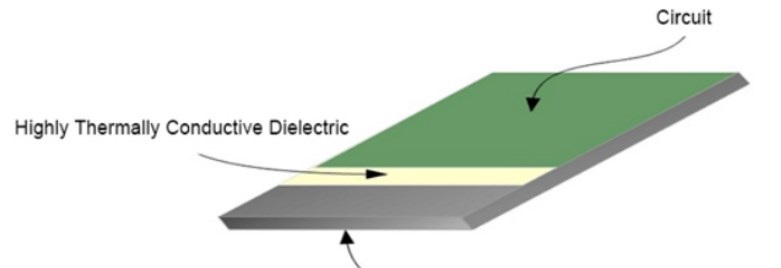Using an aluminum-based PCB is a very effective solution when the heat dissipation requirements of the design are very high. This design allows for better transfer of thermal energy away from design components, thereby controlling the temperature of the project. Typically ten times more efficient at removing thermal energy from circuit assemblies than an equivalent fiberglass backsheet. This significantly higher level of heat dissipation allows for higher power and higher density designs.
Additionally, aluminum substrate PCBs are finding application in high power/high heat dissipation applications. Originally specified for high power switching power supply applications, they have now become very popular in LED applications. Examples of LED applications include traffic lights, general lighting, and automotive lighting. Using an aluminum base design (LED PCBs) allows higher LED densities to be used in the board design and allows the installed LEDs to be driven at higher currents while still staying within temperature tolerances. Using an aluminum-based backing design allows the designer to reduce the safety margin for power LEDs and derate the LEDs compared to conventional PCB designs. As with all components, the cooler the LEDs are designed to operate, the longer those LEDs can be expected to operate before failing.
Other applications for aluminum-based PCB designs include high-current circuits, power supplies, motor controllers, and automotive applications. Aluminum-based PCBs are the ideal thermal solution for any design using high-power surface-mount ICs. Additionally, they can eliminate the need for forced air and heat dissipation, ultimately reducing design cost. Essentially, any design that can be improved with higher thermal conductivity and better temperature control is a possible application for aluminum substrate PCBs.
Where traditional PCBs use glass fiber substrates (FR4 is the standard substrate used by PCB manufacturers), aluminum substrate PCBs consist of aluminum substrates, high thermal conductivity dielectric layers, and standard circuit layers. The circuit layer is essentially a thin PCB that has been bonded with an aluminum base backing. In this way, circuit layers can be as complex as those mounted on conventional fiberglass backings.

Although it is more common to see single-sided designs, aluminum-based designs can also be double-sided, with the circuit layers connected to both sides of the aluminum base by a highly thermally conductive dielectric layer. These two sided designs can then be connected by plated through holes. Regardless of the configuration, the aluminum baseplate provides excellent thermal pathways to the surrounding environment or to any attached heatsinks. Again, improving the heat transfer of power components is the best way to ensure the reliability of your design, and aluminum PCBs provide an excellent solution to this problem.
As with traditional PCB design, the solder mask on the circuit portion of the board can be made in many different colors. That is, in LED designs, the solder mask is usually white. The white solder mask allows for a higher level of light reflection from the associated LED array and results in a more efficient design. In power supply designs, the solder mask is also usually painted black for better heat dissipation.
Aluminum-based PCB designs are also highly mechanically stable and can be used in applications that require a high level of mechanical stability or are subject to significant mechanical stress. Also, they are less affected by thermal expansion than fiberglass-based structures. If your design does not require high levels of thermal conduction, but the board will be subject to significant mechanical stress or have very tight dimensional tolerances and will experience significant heat, designing with an aluminum substrate may warrant it.
Finally, aluminum is not a usable metal backing material. Copper and copper alloys are also used as backing materials, although less popular due to their generally higher cost. Copper and copper alloys offer higher performance than aluminum in terms of heat dissipation. Therefore, if a standard aluminum-based design cannot meet the heat dissipation requirements of the design, copper can be considered as the next step in solving this problem.
All in all, using an aluminum-based solution can greatly improve the reliability and lifetime of a design through temperature control and, consequently, lower component failure rates. In addition to excellent temperature control characteristics, the aluminum design provides a high level of mechanical stability and a low level of thermal expansion. Aluminum substrates may provide the answer when standard fiberglass (FR-4) backplanes cannot meet the thermal and density requirements of your design
 Meizhou Ruiputuo Technology Co.,Ltd
Meizhou Ruiputuo Technology Co.,Ltd